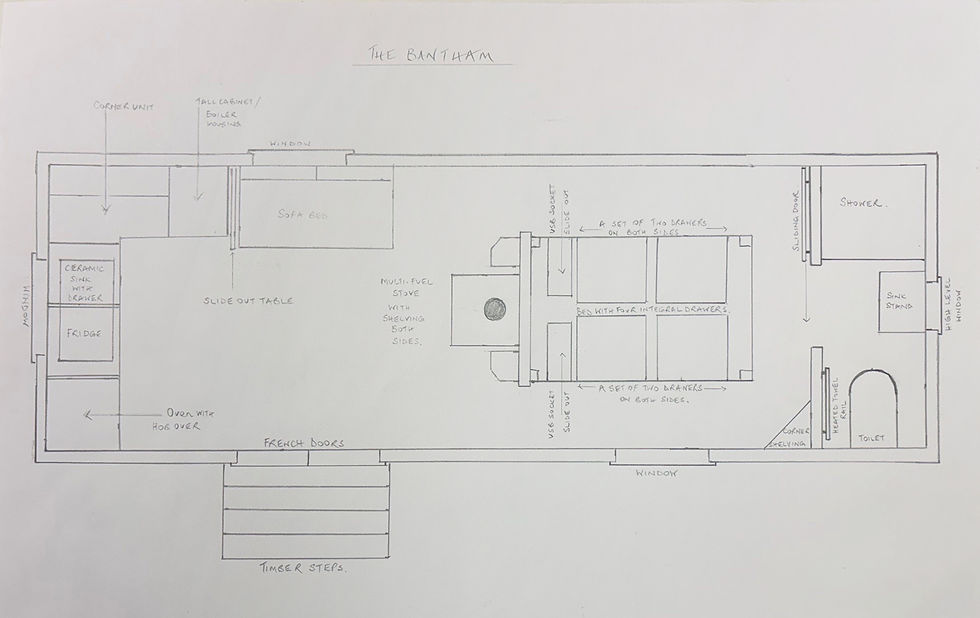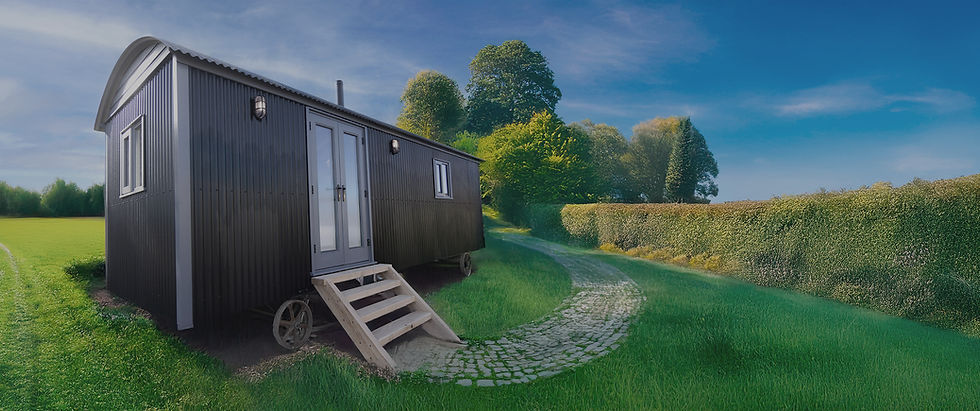Planning Permission for Shepherds Huts: What You Need to Know
- Kerri Cuthbert

- May 1
- 6 min read
Updated: Jun 17
If you’re thinking about putting a shepherd’s hut on your land, one of the first questions you might have is: “Do I need planning permission?” It’s a common concern — and the answer isn’t always black and white.
Whether you need permission will depend on how you plan to use the hut, where you want to place it, and whether it’s seen as a building or something that can be moved.
In this guide, we’ll explain what planning permission is, when it’s usually required for shepherd’s huts, and how to approach the process with confidence — even if you’ve never dealt with it before.

Do You Need Planning Permission for a Shepherds Hut?
In many cases, you may need planning permission for a Shepherds Hut, particularly if:
The hut will be used as a permanent dwelling.
It will be rented out as a holiday let.
It will be connected to services such as water, drainage, or electricity permanently.
It will remain in one place long-term without wheels or without the ability to move easily.
If your hut is truly mobile (for example, on wheels and capable of being towed), is used occasionally, and is not fixed in place, you may not need permission — but it’s not guaranteed. Planning rules vary across the UK, and what’s allowed in one area may not be permitted in another.
For more on how Shepherds Huts are used, see our guide: What Are Shepherds Huts Used For?
Factors That Influence Planning Permission
There are a few important factors that will influence whether or not you need planning consent for your shepherd’s hut. Here’s what local councils typically take into account:
1. Intended Use
Living in it full-timeThis is classed as a new dwelling, which means you’ll almost certainly need full planning permission.
Using it as a holiday letIf you’re renting it out — especially if it’s advertised online — it will likely be treated as a business and require permission.
Using it as a garden office or studioIf the hut is only used in connection with your main home, you might not need permission. That said, it’s always worth checking, as some councils still require you to apply.
2. Location
The location of your shepherd’s hut plays a big role in whether planning permission is needed.
If you're placing the hut in a sensitive or protected area, you’ll likely face stricter rules.
This includes:
National Parks
Areas of Outstanding Natural Beauty (AONBs)
Green Belt land
These areas have tighter controls to preserve the natural landscape, so any new structure — even a hut — may need more scrutiny.
Other things that can raise planning concerns include placing the hut:
Close to a road, boundary, or public footpathThese spots tend to be more visible and may attract extra attention from planning officers.
Within two metres of your property’s boundaryEven if the hut is just for personal use, placing it too close to the edge of your land can trigger planning requirements.
Councils will also look at the visual impact — in other words, how much the hut changes the look or feel of the area. This is especially important in scenic or rural locations.
Considering a hut in a rural or scenic area? You may also want to read: Choosing the Perfect Location for Your Shepherds Hut
3. Mobility
A Shepherds Hut that is easily movable (e.g., retains working wheels and can be towed) may sometimes be treated similarly to a caravan.
Once sited permanently and landscaped around, it is often regarded as a building, triggering the need for planning.
4. Size
Size can also influence the need for planning permission. Larger huts, particularly those with fixed facilities such as full kitchens and bathrooms, are more likely to be seen as permanent dwellings rather than moveable structures.
In some areas, if the hut exceeds particular height or footprint limits set by local policies, additional regulations may apply, even if the hut remains technically mobile.
Smaller, simpler huts are sometimes treated more leniently, but it is always best to confirm with your local authority.
Common Scenarios: When Planning Permission Is Typically Needed
Understanding whether you need planning permission for a shepherd's hut depends on various factors, including its intended use, location, and permanence. These examples should help you get a clearer sense of what to expect — though it's always best to confirm with your local authority.
Scenario | Planning Permission Likely Needed? |
Living full-time in a Shepherds Hut | Yes |
Using a Shepherds Hut for Airbnb or holiday rentals | Yes |
Shepherds Hut as a garden office (ancillary use) | Maybe not, but check locally |
Temporary occasional accommodation (no services connected) | Often no, but check |
Tip: Regulations can vary between local authorities, and other factors such as the hut's size, proximity to boundaries, and connection to utilities can influence the need for planning permission. Always consult your local planning office for advice tailored to your specific circumstances.
How to Apply for Planning Permission
Applying for planning permission for a shepherd's hut might seem daunting, but understanding the process can make it more manageable. Here's a step-by-step guide to help you navigate the application:
1. Pre-application enquiry: Before submitting a full application, it's advisable to engage in a pre-application enquiry with your local planning authority. This informal process allows you to discuss your proposal and receive feedback on potential issues or requirements. It can help identify any constraints and increase the likelihood of a successful application.
For more information, visit the UK Government's guidance on pre-application advice.
2. Full planning application: A comprehensive application typically includes:
Site Plan: A detailed map showing the location of the proposed hut.
Design and Access Statement: Explaining the design principles and how access will be provided.
Supporting Documents: Such as ecological assessments or flood risk assessments, if required.
Ensure all documents are accurate and complete to avoid delays.
3. Submit the Application
Applications are usually submitted online through the Planning Portal or directly to your local council. Fees vary depending on the nature of the development.
3. Wait for approval: Once submitted, the local planning authority will review your application. The standard decision period is eight weeks, but this can extend for more complex proposals. During this time, neighbours and other stakeholders may be consulted.
Tips for Making the Planning Process Smoother

Making the planning process easier often comes down to early preparation, good communication, and thoughtful design. Here are a few tips that can help things go more smoothly:
Engage Early with Your Local Planning Authority:
Initiate a conversation with your local planning department before submitting any applications. Early engagement can help identify potential issues and clarify requirements specific to your area.
Emphasise the Hut's Mobility:
If your shepherd's hut is on wheels and not permanently fixed, highlight its mobility in your application. Mobile structures may be subject to different regulations compared to permanent buildings.
Consider the Hut's Design and Placement:
Design your hut to blend seamlessly with its surroundings. Using natural materials and colours can make the structure less obtrusive. Additionally, positioning the hut away from boundaries and not in front of the main dwelling can be beneficial.
Understand Permitted Development Rights:
Some developments may fall under permitted development rights, meaning they don't require full planning permission. However, these rights have limitations and vary by location. It's essential to verify if your project qualifies.
Always remember: consult your local planning authority to confirm whether your shepherd's hut project requires planning permission.
FAQs
Do all Shepherds Huts need planning permission?
Not in every case. Whether or not planning permission is needed depends largely on how you intend to use the hut, whether it remains mobile, and the nature of the location where it is sited. It is always best to check with your local authority for advice specific to your situation.
Can I live full-time in a Shepherds Hut without planning permission?
In most cases, no. Living permanently in a Shepherds Hut is typically classed as a change of land use or the creation of a new dwelling, both of which require full planning permission from your local council.
Does a mobile Shepherds Hut still need permission?
If the hut is truly mobile and used occasionally, you may not need planning permission, but it is always advisable to check with your local council.
Do I need planning permission to use a Shepherds Hut as a home office?
Possibly not if the hut is considered ancillary to your main house, but it depends on your local planning authority's interpretation.
How long does it take to get planning permission for a Shepherds Hut?
Most planning decisions are made within eight weeks of submitting a full application.
Final Thoughts
Planning permission for Shepherds Huts isn't always needed, but understanding the regulations early on can save you time and stress later.
At Tiny Homes, we focus on designing and crafting high-quality, bespoke Shepherds Huts that suit a variety of uses and lifestyles.
Ready to start your journey? Explore our Ultimate Guide to Shepherds Huts and learn everything you need to know!















Comments